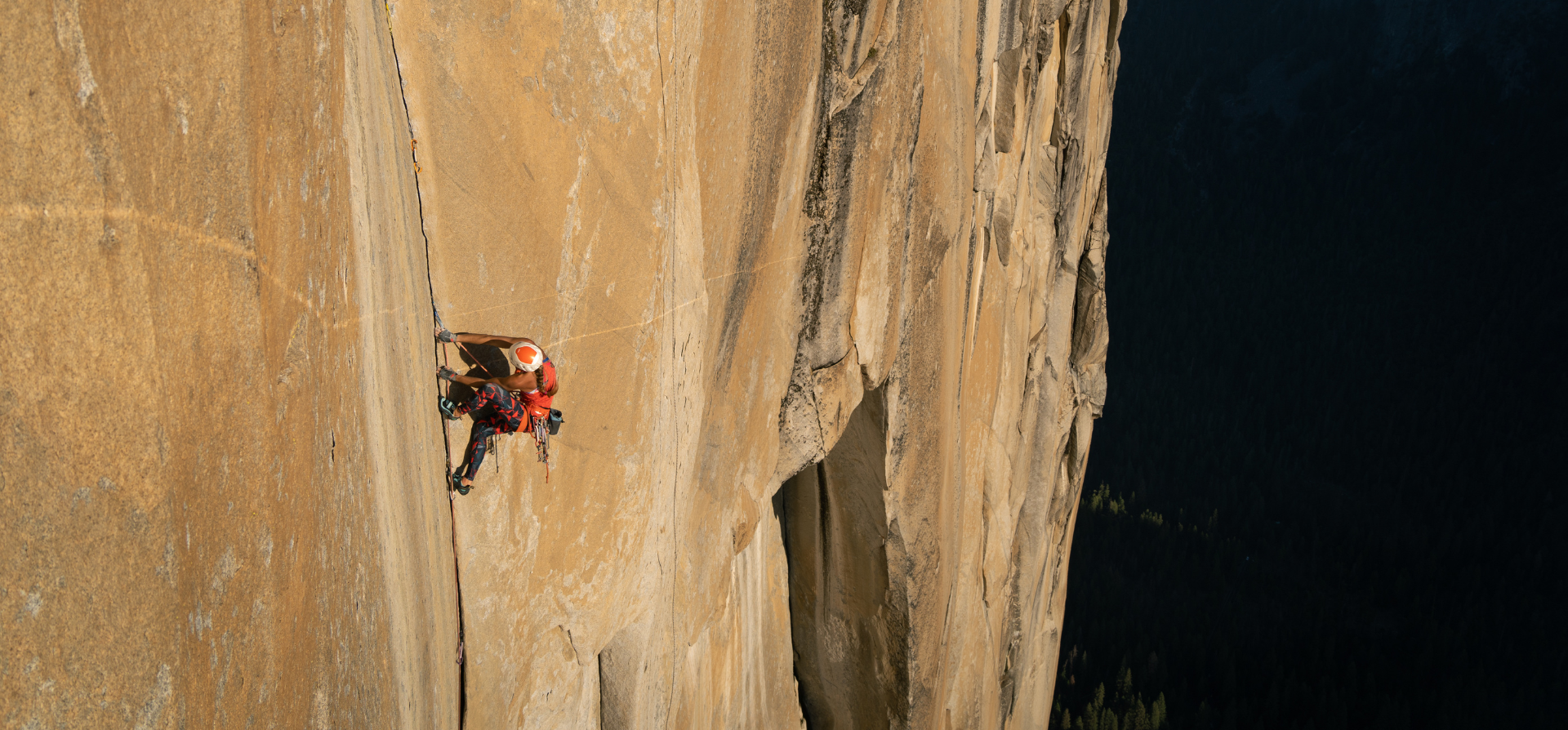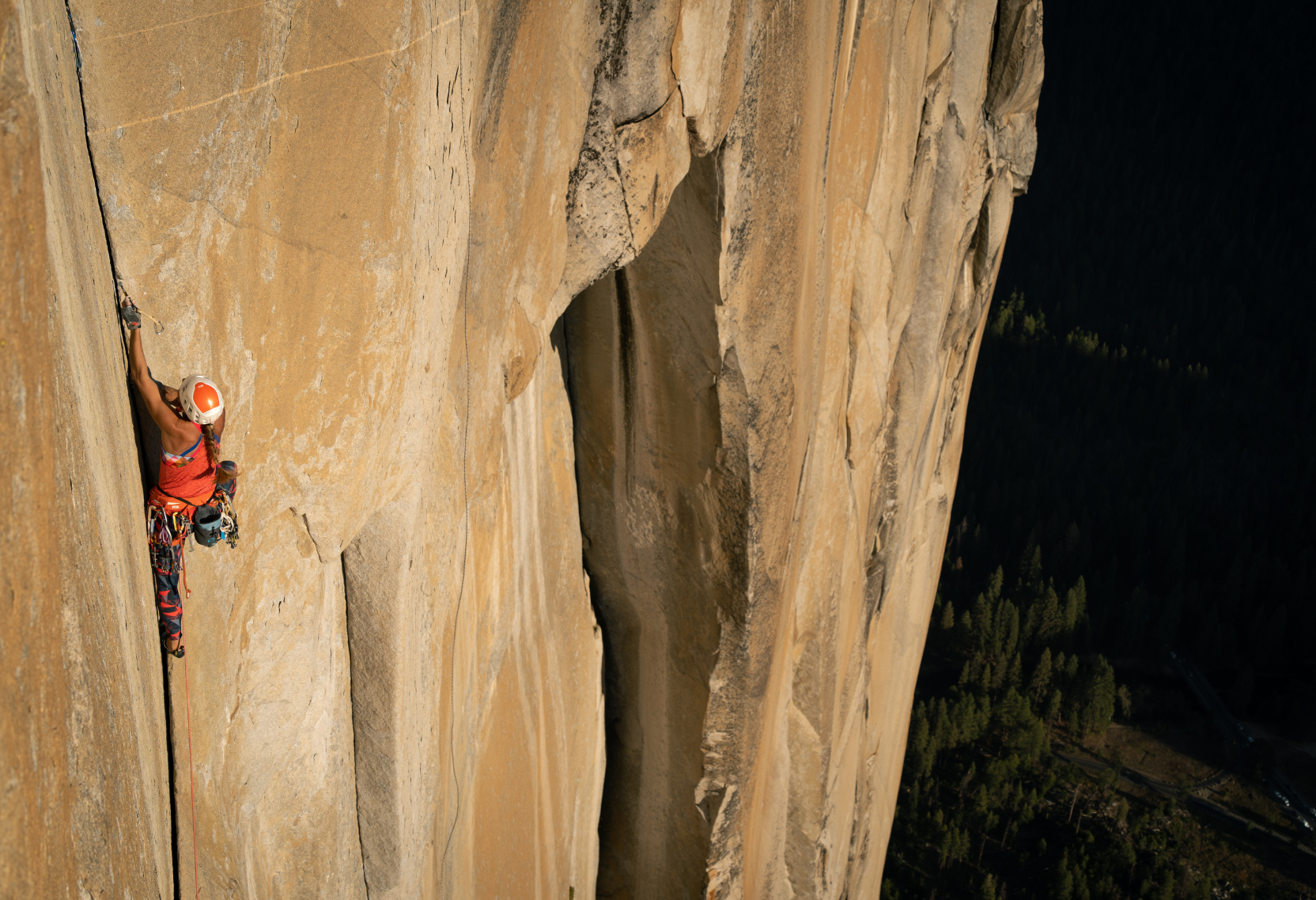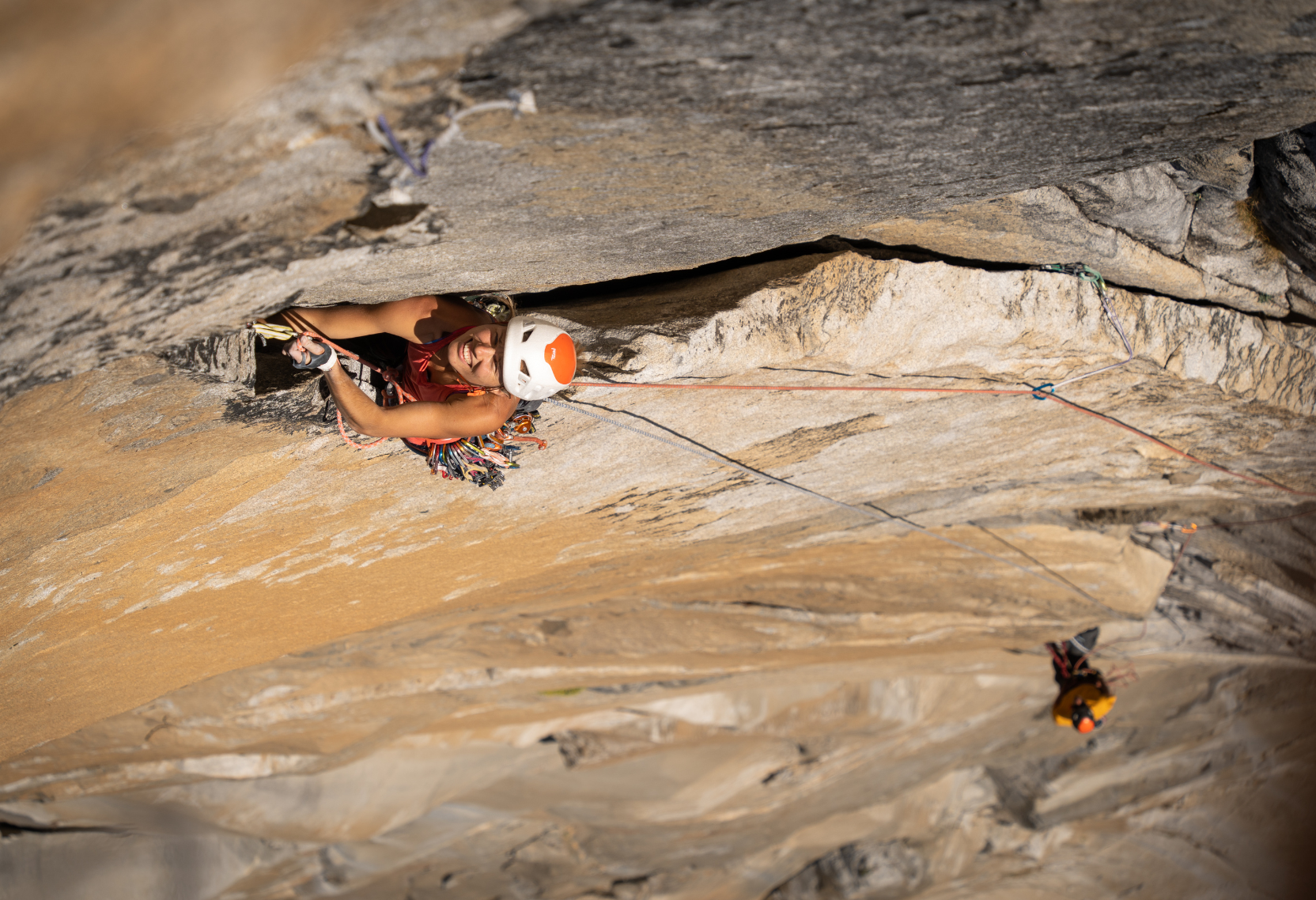After freeing El Capitan's Freerider in 2018, Michaela Izakovičová returns to Yosemite to set her sights higher still.
Words by Miška Izakovičová
Free climbing Golden Gate has been my dream since 2019. When I tried it for the first time, the climbing seemed out of reach. My climbing partner and I somehow managed to get to the top of the route, but I couldn't imagine ever climbing the whole route free. The step up in difficulty compared to Freerider is enormous. However, when CoVid happened and traveling was impossible, one could only dream. My dreams were about Golden Gate. I began to believe and hoped that I would go back one day.
I came back in the fall of 2022, and although it went significantly better than before, the route still seemed quite hard to me. On one of the crux pitches "The Move Pitch," true to the name, I couldn't even do the move. However, the dreams began again and I felt that if I came back stronger and better prepared, it could maybe go.
When I injured my ankle in the spring, it seemed like I wouldn't have any chance to climb Golden Gate this year. I couldn't walk for about two months and was out of climbing for almost three months. I thought I wouldn't even make it to Yosemite this year. However, in the fall, I got back to climbing at my local area, Adršpach. Surprisingly, I felt strong, so I decided to go to the Valley and see.
When I arrived, I struggled to find climbing partners to try Golden Gate with. I knew the effort it would require and wanted to find the right partner. I felt a bit guilty that I was selfishly choosing who to climb with, but when you invest so much energy and travel halfway across the world for something, you want to do everything you can to have the best chance of succeeding.
In the end, it worked out exactly as it should have. Karel Nováček, from Adršpach, decided to come at the last moment. We climbed a lot together in Adršpach in the fall. I knew intrinsically he would be the perfect climbing partner for Golden Gate. What seemed like science fiction to me just two months ago was starting to become a reality. I was in Yosemite, feeling quite strong, supported by a great climbing partner, and everything was ready for the attempt.
The night before getting on the wall, I couldn't fall asleep for a long time. A million thoughts were swirling in my head:
"I must have lost my mind thinking I can climb this, considering that in the past year, I only managed to climb a total of four pitches of 5.13. That's exactly how many 5.13 pitches I'll have to climb on Golden Gate in the next few days.”
I cursed myself for telling everyone that I felt close to sending it last year.
“Now everyone expects me to do it. What if I can't do it at all and it becomes a complete disaster?”
I comforted myself with the thought that, worst-case scenario, I can blame it on my injury. That felt quite pathetic. I simply have to give it everything and hope that I'll be lucky enough to send it.
I started going through the entire route in my head to try to focus on the climbing. It didn't help much. In fact, it may have stressed me out even more when I realized how many strenuous and uncertain pitches awaited me. On the first day alone, I had several question marks. The slabs on the Freeblast might look like they could be ridden down on a bike, but I always felt like I could fall off at any moment. Not to mention the boulder on the pitch of Heart Ledges. I had to try that pitch three times last year. Until now, I had avoided slabs in Yosemite. What if it comes back to haunt me now?
The second day, there’s the Monster offwidth. I'm mainly worried about the downclimb to it. Although I've always climbed it, I've never felt secure, and as for the Monster itself, it's always draining, even though I feel like I am a pretty decent offwidth climber. And from the moment the route diverges from Salathé Wall/Freerider, there's some sort of difficulty in almost every pitch.
Right from the start, you need to climb the first crux pitch, the Downclimb (5.13), which is considered the most difficult pitch for many. To me, it seemed to be the easiest of the crux pitches, it is purely technical, but mainly I had the feeling that it was the only hard pitch that I could keep trying over and over again, so there is the biggest chance of sending it.
From there to the top, almost all the pitches are quite demanding. Not because I would feel like I could fall on them, but because they were either quite runout, a bit scary or just physically very demanding. Obviously, I expected falls on the remaining three crux pitches, which were even more of a question mark for me than the Downclimb.
I was most afraid of the second crux pitch, The Move Pitch. It contained a boulder problem that I couldn't even do last year.
“Will I be telling everyone how close I was to climbing it, when in reality I was actually so far because I didn't even make any progress? How do I mentally prepare myself for the possibility of not being able to do it again? And what about the other two crux pitches? I'm not as afraid of the Golden Desert pitch, I managed to do it last year, but A5 Travers is super pumpy, and it's possible that after so many days of climbing, I won't have the energy to do it. I know several people who didn't send the route because of that. What if it's also my case? Will I have enough time to work and climb all the pitches?”
It's already clear that my original plan to spend 10 days on the wall won't work out. According to the forecast, we have 7 days of good weather, then 4 days of rain, and then we're flying home. It's incredible how these thoughts can be so stressful.
After a night of cyclical negative thought, I decided I just need to stop thinking about it and focus only on climbing, pitch after pitch, and not worry about anything else.
Next morning, I woke up ready to give it everything. The first two days on the wall went exactly as planned. I was climbing very well, the slabs on Freeblast seemed surprisingly easy to me. I managed to send the boulder at the Heart Ledges in total flow. Unfortunately, the Monster offwidth was just as hard as always. Offwidth training didn’t make it less strenuous. We climbed up to the Downclimb without any problems, and if it weren't for the heavy haul bags, I wouldn't be even very tired. On the third day I only wanted to practice the Downclimb. We would rest during the day while the sun was shining. However, first I had to get up at 4:30am to work the pitch, so that I have as much time as possible before it gets in the sun.
On the first try, I fell at the crux. I climbed well, but I was quite nervous. I tried not to have any expectations, but it really was the first test of how I would do on those hard pitches. However, I managed to do all the moves right away, which gave me enough confidence for the second try. There, I didn't hesitate at all and sent the pitch. Since I did that in about half an hour, it made sense to continue up that day. Somewhere deep down, I was still stressed that I didn't have enough time for how much hard climbing I still had ahead of me. We decided to use the rest of the day to move the camp to Tower to the People. It's only 6 pitches, but almost all of them are long and quite demanding. We also had to climb through one of the crux pitches, The Move Pitch.
I got to the Tower to the People totally exhausted. In the last three days, I had climbed 30 pitches, and I had led all of them, which in big wall climbing means not only climbing but also hauling and belaying. It was clear to me that getting up again at half past four in the morning the next day and trying the hardest pitch didn't make sense so I decided for a partial rest day instead.
The whole day I was trying not to think about the fact that I might find my nemesis on the Move Pitch once again. What was even worse, yesterday when I climbed through it, I discovered that a crucial foothold was broken, making the short people beta, which I had tried last year, even harder. At sunset, we rappelled down. I started figuring out the moves. It didn't make sense to give it serious redpoint attempts until I figured out the boulder. So, I hung there for over an hour, trying every possible method that came to mind, each one more awkward than the last, and all of them pretty unrealistic. It seemed like I just wouldn't be able to climb it.
Karel encouraged me, saying that I still had plenty of time and that I would figure it out somehow. After a short rest, I went back to try again. It was already dark and I could only see a piece of rock illuminated by my headlamp. A piece of rock that might be the reason I won't climb this route. In my heas, I was replaying all the methods I had already tried, and after a while, another one came to mind. I couldn’t do it immediately, but at least it didn’t feel unreal. With each try, I was getting closer and closer until suddenly I did the whole sequence. I was already very tired, and I knew that I didn’t have the energy for a serious try. I decided to wait until morning when I would have a better chance in daylight. However, that also means we will have to wake up at half past four again.
I didn’t know what to expect. I still had the feeling that when I returned there in the morning I wouldn't be able to do the moves. On the way down, I stopped at the boulder to try it one more time before the attempt. Surprisingly I did the moves on the first try, without any warm-up. I was ready for the try. I climbed very well from the beginning of the pitch and once below the crux, I felt completely fresh. At the crux I tried as hard as I could, and it paid off. I climbed the entire pitch flawlessly, without a single mistake or hesitation, and suddenly I had the feeling that sending Golden Gate might be realistic.
I considered the Golden Desert pitch to be the easier of the cruxes, and I thought I would climb it in about two tries. When I tried the pitch that evening, I realized it might not be as easy as I thought. On the first try, I fell with lot of slack while I was clipping a cam, and I even pulled out another one below me. On the second try, my foot slipped and while falling I somehow reinjured my ankle. It started hurting badly, and I thought I wouldn't be able to climb anymore. I only had two days left, and I still had to climb two crux pitches and then another five pitches to the top. Fortunately, I had a great support in Karel, who never doubted for a moment that I would climb the route. He calmly said, "Let it be for today, you'll climb it tomorrow. We still have plenty of time."
I had hoped that I will get enough rest overnight and climb much better the next day, but I couldn’t sleep very well. My ankle was in pain, and I was stressing out a bit, thinking that I had no chance to climb the route. I woke up at four in the morning, giving myself enough time before the sun hit the wall. On the first attempt, I was very shaky, my ankle was hurting and swollen, and I was afraid of falling again and making it worse. I couldn't focus on climbing at all. I tried to convince myself that it was just a warm-up attempt and that I would climb it on the next try. But when I fell three more times on that pitch that morning, I started to feel really miserable. Will I really not be able to climb the route because of a pitch that is generally considered the easiest of the crux pitches? Sending it seemed miles away now. The sun was already shining on the wall, and I didn't know what to do next. I wanted to keep trying the pitch over and over until I climbed it, but I knew that would be foolish.
Fortunately, Karel supported me again, suggesting that I should try the next, final crux pitch the A5 Traverse for a change. I felt really tired and had almost no skin left, but it was probably the only thing that made sense. But of course, I was struggling.
The rock was already too warm, my arms were sore, and I could barely do the moves. The second try was no better, and I knew that if I tried one more time, I would start bleeding from my fingertips. My head was not in a good place, and to be honest, I was already looking forward to be at the top and rest. I was done, too tired. I couldn’t see any chance to climb both pitches on the very last day.
That evening Sam Stroh cheered me up. He was climbing El Corazon in-a-day. He got to our portaledge camp right after sunset. His excitement and positive energy radiated all over the place. He only had two more hard pitches left, Golden Desert and the A5 Traverse. He was doing great, he already climbed the hardest crux pitches of the route. He took a moment to rest on our portaledge. He told me, that when he freeclimbed Golden Gate a year and a half ago, he needed five tries to send Golden Desert. He also thought that the A5 Traverse is two grades easier when it is not in the sun. I had only tried it in the sun, so he gave me hope that I could still send those pitches in the morning. Lying in the portaledges, I watched Sam sending both pitches and I knew that I was not gonna give up on my dream.
The next morning I felt surprisingly fresh. Sam’s positive energy was my positive energy. I was climbing much better already on the first few moves. I had a feeling that someone had turned off the gravity on El Cap while I slept. I still had to try hard at the crux, but I sent Golden Desert with a smile the whole way. Now, there was only the A5 Traverse left. I had a maximum of two tries before the sun, but I knew that I had to climb it first try, otherwise my chances would be very slim. I don’t think I’ve ever fought so hard on any pitch of rock climbing in my life. I was really pumped and I was about to fall on every move already from the halfway of the pitch. I still can’t believe I could hold on.
After reaching the belay, it took me a few minutes to stop cramping in my forearms and realize that I had actually done it. From that point, I just needed to stay present. I tried to suppress tears of happiness. I knew that it's not over until you are standing on the top. Fortunately, I had so much adrenaline and sending euphoria that I managed to find enough energy to climb to the summit later that day.
We topped out at a beautiful sunset. I was really exhausted and I hadn't fully grasped what had just happened. It took me a while for the sending euphoria to kick in. It only came at night when I lay down in my sleeping bag at the top of El Capitan. That night, I didn't sleep at all. I kept replaying all the memories from the climb in my head and enjoying those beautiful feelings when you fulfill your biggest dream.
Golden Gate is by far the hardest route I’ve ever climbed. I really value this ascent because I freed it in the style I dreamed of and, even beyond Karel and Sam, I had so people on the wall and in my heart expand the experience beyond the route. The journey that was climbing Golden Gate was beyond anything that I had dreamed.
Featured Kit
More from Miska
Miška is from Slovakia but spends much of her year travelling to find the lines and projects that inspire her. You’re just as likely to run into her in Yosemite, Chamonix, or at Chulilla as you are on her local crags. One of the most motivated rock climbers you’ll meet she’s as comfortable on big walls as on sport routes...
Find out more about Miška and the rest of the Mountain Equipment Team on our Team Pages.









